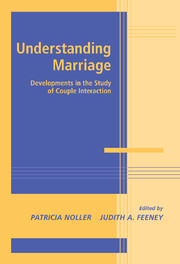Book contents
- Frontmatter
- Contents
- Contribitors
- Introduction
- SECTION ONE THE EFFECT OF COGNITION ON INTERACTION PATTERNS
- SECTION TWO UNDERSTANDING THE IMPORTANCE OF POSITIVE INTERACTION
- SECTION THREE COPING WITH DISAPPOINTMENT, CRITICISM, AND BETRAYAL
- SECTION FOUR POWER, CONFLICT, AND VIOLENCE IN MARITAL INTERACTION
- Introduction to Section Four
- 11 Demand-Withdraw Communication during Couple Conflict: A Review and Analysis
- 12 Approaches to the Study of Power in Violent and Nonviolent Marriages, and in Gay Male and Lesbian Cohabiting Relationships
- 13 The Communication of Couples in Violent and Nonviolent Relationships: Temporal Associations with Own and Partners' Anxiety Arousal and Behavior
- Marital interaction at important transition periods
- SECTION SIX Interventions for strengthening relationships
- Conclusions
- Index
- References
Introduction to Section Four
Published online by Cambridge University Press: 25 July 2009
- Frontmatter
- Contents
- Contribitors
- Introduction
- SECTION ONE THE EFFECT OF COGNITION ON INTERACTION PATTERNS
- SECTION TWO UNDERSTANDING THE IMPORTANCE OF POSITIVE INTERACTION
- SECTION THREE COPING WITH DISAPPOINTMENT, CRITICISM, AND BETRAYAL
- SECTION FOUR POWER, CONFLICT, AND VIOLENCE IN MARITAL INTERACTION
- Introduction to Section Four
- 11 Demand-Withdraw Communication during Couple Conflict: A Review and Analysis
- 12 Approaches to the Study of Power in Violent and Nonviolent Marriages, and in Gay Male and Lesbian Cohabiting Relationships
- 13 The Communication of Couples in Violent and Nonviolent Relationships: Temporal Associations with Own and Partners' Anxiety Arousal and Behavior
- Marital interaction at important transition periods
- SECTION SIX Interventions for strengthening relationships
- Conclusions
- Index
- References
Summary
Power is a critical concept in marital relationships, relevant to issues such as decision making, task allocation, and conflict resolution. Although some marriages are relatively equal in terms of power (Schwartz 1995), other marriages can be ongoing struggles for power and dominance. Power can be expressed in a variety of ways and many arguments in marriage are really about who has the power to exert influence and make decisions. Power can also be expressed in more indirect ways such as refusing to discuss an issue or engaging in manipulative behavior. Withdrawing from conflict, in particular, may stem from a desire to exert control by maintaining the status quo.
Although the demand/withdraw pattern of conflict interaction has recently come to prominence in the work of Christensen and his colleagues, it actually has a long history. For example, Watzlawick, Beavin, and Jackson (1967 discussed a pattern of marital interaction involving a conflict-avoidant person (usually the male), and his partner who is frustrated by the avoidance and demands that the problem be confronted. Consistent with this focus in the therapy literature, Eldridge and Christensen present evidence that the demand/withdraw pattern is associated with relationship dissatisfaction, although the direction of causality is still not fully understood.
As Christensen and Eldridge discuss, a number of explanations for the demand/withdraw pattern have been proposed. These explanations focus on gender differences in the experience and expression of emotion, individual differences in personality and in desires for intimacy, discrepancies in power and status favoring men, and the specific structure of the conflict topic (that is, which partner is seeking change).
Information
- Type
- Chapter
- Information
- Understanding MarriageDevelopments in the Study of Couple Interaction, pp. 285 - 288Publisher: Cambridge University PressPrint publication year: 2002
